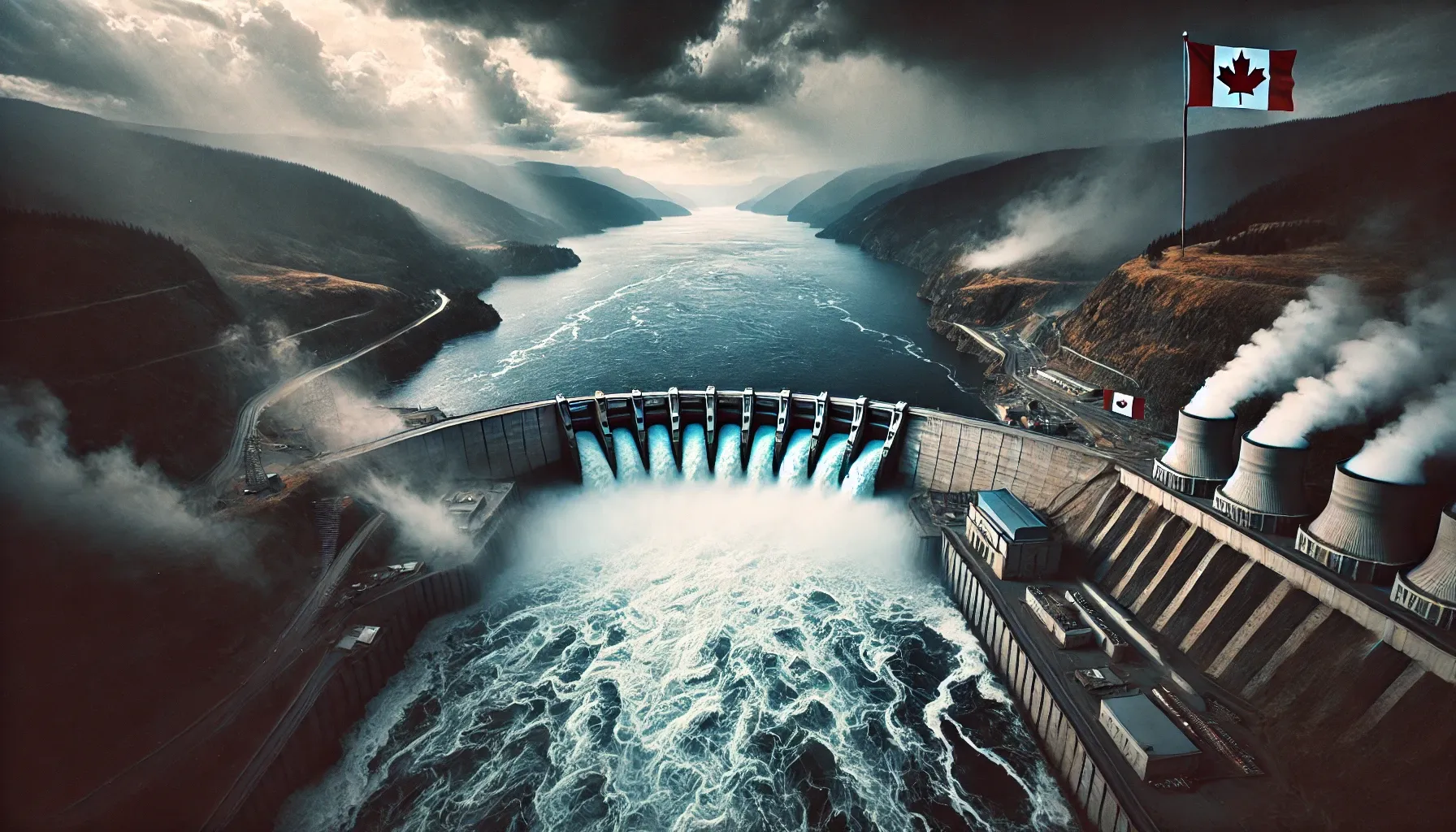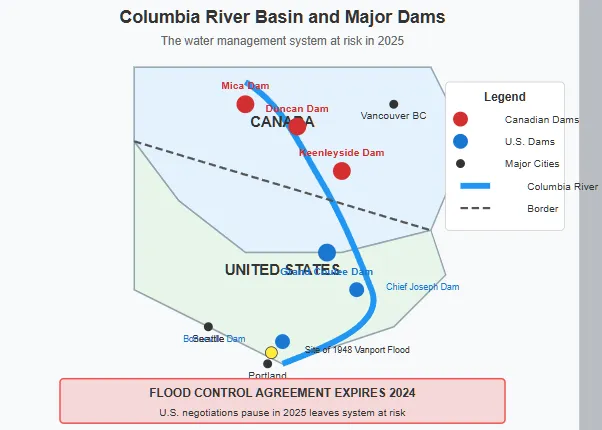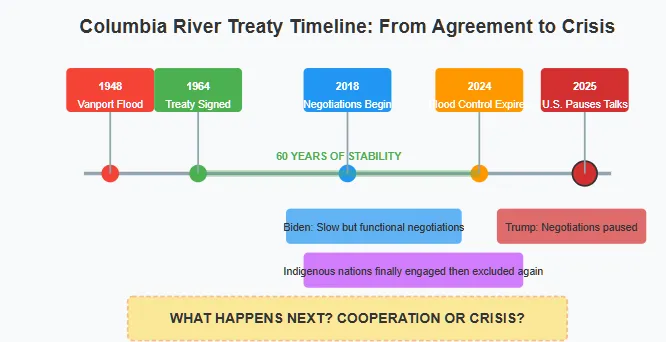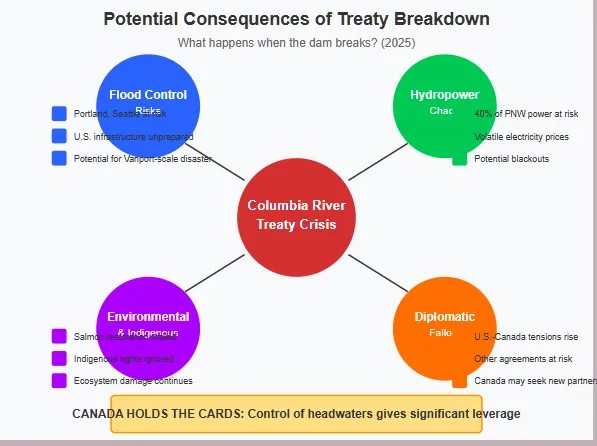Address
304 North Cardinal St.
Dorchester Center, MA 02124
Work Hours
Monday to Friday: 7AM - 7PM
Weekend: 10AM - 5PM

For over half a century, the Columbia River Treaty quietly kept the Pacific Northwest from descending into chaos. It wasn’t flashy, it wasn’t controversial—just a practical agreement between the U.S. and Canada to manage one of the continent’s most powerful waterways. Canada built dams, controlled water flow, and in return, the U.S. got predictable hydropower and a safeguard against catastrophic flooding. It was the kind of bureaucratic stability that governments love—until now.
The U.S. just hit pause on negotiations to renew the treaty, throwing the entire agreement into limbo. What does that mean? Potentially, a whole lot of economic and environmental pain on both sides of the border. Without a new deal, flood control expired in 2024, and power supply disruptions could follow. Indigenous nations—already sidelined in the original agreement—face another round of exclusion. And for Canada, this isn’t just about water; it’s about whether Washington still treats them as a real partner or just another obstacle.
So why did the U.S. walk away? Is this a bargaining ploy, or is it part of a broader strategy to strong-arm Canada into concessions? More importantly, what happens next? Because when negotiations freeze on something this fundamental, the floodgates—metaphorically and literally—start creeping open.

Back in 1964, the U.S. and Canada weren’t exactly in crisis mode, but they saw the writing on the wall. The Columbia River—one of North America’s most powerful waterways—was both a blessing and a potential disaster. It powered homes, irrigated farms, and fueled economies, but it also had a nasty habit of flooding entire towns when left unchecked. After a particularly devastating flood in 1948 wiped out Vanport, Oregon, officials in both countries realized they needed a permanent fix.
Enter the Columbia River Treaty—a pragmatic, unglamorous deal built on mutual benefit. Canada agreed to build three massive dams (Mica, Duncan, and Keenleyside) to regulate water flow and prevent flooding downstream. In return, the U.S. compensated Canada for lost land and environmental impact while securing a reliable energy source for the Pacific Northwest. The treaty worked because it was simple: flood control, power generation, stability.
For six decades, this agreement largely operated in the background, quietly ensuring that cities like Portland didn’t end up underwater and that hydroelectricity remained a cheap, renewable energy source. There were no public spats, no dramatic renegotiations—just quiet, bureaucratic efficiency. But the world has changed. Climate change is reshaping water needs, Indigenous nations are demanding a say in resource management, and geopolitics is making even the most routine agreements contentious.
And now, with the U.S. walking away from negotiations, the entire system is at risk. Flood control is set to expire in 2024, meaning Canada is no longer obligated to hold back surging waters. If a deal isn’t reached, both countries could be looking at economic and environmental disaster. And this time, there’s no Cold War-era goodwill to keep things civil.
For years, everyone knew the Columbia River Treaty needed an update. Climate change, shifting energy demands, and long-ignored Indigenous rights made the 1964 framework increasingly outdated. Both the U.S. and Canada agreed—on paper—that a modernized treaty was necessary. In 2018, formal negotiations began, and by mid-2024, an “in-principle” deal was on the table. Then, suddenly, the U.S. slammed on the brakes.
So what changed? The short answer: American politics. The longer answer: a combination of strategic leverage, election-year maneuvering, and a fundamental shift in how Washington views its closest allies. Under President Biden, treaty talks had been slow but functional. His administration pushed for a more equitable deal, acknowledging environmental concerns and the need for Indigenous representation. But when Trump returned to power in 2025, the calculus shifted.
Behind the scenes, American hydropower interests have been pushing for a better deal. The U.S. currently sends “Canadian Entitlement” payments—essentially compensation for flood control and stored water benefits—to British Columbia. Some American policymakers view this as outdated, arguing that Canada has already been paid enough. Others see it as a strategic move: by stalling negotiations, the U.S. can pressure Canada into accepting less favorable terms down the line.
The problem? This isn’t just about political posturing. If the treaty lapses without a replacement, the Pacific Northwest faces real risks. The Columbia River’s flow will no longer be coordinated, making flood prevention unpredictable. Power generation will become more volatile. And the long-term damage to U.S.-Canada relations could extend far beyond this one agreement.
The U.S. thinks it’s playing chess. But with flood control set to expire, they might be playing Russian roulette.
For decades, the Columbia River Treaty functioned like an invisible safety net. The general public didn’t think about it because they didn’t have to—floods were controlled, hydropower was steady, and the system just worked. But now, with negotiations frozen and flood control set to expire in 2024, that safety net is fraying fast.
So, what happens when the U.S. walks away? The answer is a mix of higher costs, increased risks, and geopolitical fallout.
Right now, Canada controls water storage at three major dams, preventing devastating floods in cities like Portland, Vancouver (WA), and even smaller towns downstream. Under the original treaty, the U.S. paid Canada for this service, essentially outsourcing part of its disaster prevention.
With the agreement stalled, that responsibility reverts entirely to the U.S. And here’s the problem: American infrastructure isn’t built to handle it. The U.S. Army Corps of Engineers relies on coordinated releases from Canadian reservoirs to avoid floods—without them, American cities are one bad storm cycle away from catastrophe. The 1948 Vanport disaster wiped an entire town off the map; without a treaty, something similar could happen again.
The Columbia River isn’t just a scenic wonder—it’s a hydroelectric powerhouse. 40% of the Pacific Northwest’s electricity comes from hydropower, much of it dependent on coordinated water releases. If Canada decides to change water storage practices, American energy planners will have to scramble to keep the grid stable.
That could mean:
✅ More volatile electricity prices
✅ Increased reliance on fossil fuels (a direct contradiction to U.S. clean energy goals)
✅ Potential blackouts or energy rationing in extreme cases
And while the U.S. might see this as a leverage move—less water, less power, more negotiating pressure on Canada—it’s a high-stakes gamble with real economic consequences.
The Columbia River Treaty was originally 100% about flood control and power. Not a single word was written about ecosystems, salmon populations, or Indigenous stewardship. That was the 1960s—this is 2025.
The river is home to fragile salmon populations, and its dams have already devastated traditional spawning routes. Indigenous nations, which were cut out of the original treaty, have fought for decades to have their voices heard in renegotiations. With talks paused, those efforts are now in limbo, meaning:
For many Indigenous nations, this is yet another broken promise. They were told a modern treaty would finally recognize their rights and concerns. Instead, they’re watching Washington walk away from the table entirely.
Canada isn’t powerless here. If the U.S. wants to play hardball, British Columbia can retaliate in several ways:
The U.S. might think it’s gaining leverage, but in reality, it’s creating instability on every front—energy, environment, and cross-border relations. With flood control set to expire, hydropower at risk, and no clear path forward, the Columbia River isn’t just a water dispute anymore.
It’s a flashpoint.
And if no one steps in to fix it, the Pacific Northwest might be the first to pay the price.

If there’s one group that’s seen this play out before, it’s Indigenous nations along the Columbia River. In 1964, when the original treaty was signed, they weren’t just excluded from the negotiations—they weren’t even an afterthought. The treaty’s priorities were hydropower and flood control, and Indigenous concerns—like fisheries, water rights, and environmental sustainability—didn’t make the cut. The result? The treaty devastated traditional fishing grounds and permanently altered the river’s ecosystem without so much as a consultation.
Fast-forward to 2025, and Indigenous leaders were finally on track to get a seat at the table. Renegotiations were supposed to address the past wrongs: restoring salmon populations, incorporating Indigenous governance, and ensuring water rights were respected. And then? The U.S. walked away, leaving Indigenous concerns hanging in the wind—again.
When the Columbia River Treaty was signed, Indigenous groups weren’t consulted at all. This was business-as-usual in the 1960s—international agreements were handled government-to-government, and those governments didn’t see Indigenous nations as equal stakeholders. The result?
Over the past decade, Indigenous leaders fought to fix what the 1964 treaty ignored. They demanded a modernized agreement that didn’t just focus on water storage and energy, but also:
✅ Salmon restoration efforts – Many Indigenous communities rely on fishing for subsistence and trade.
✅ Recognition of Indigenous water rights – Tribes and First Nations control large portions of the Columbia’s tributaries.
✅ A real seat at the table – Instead of being an afterthought, Indigenous nations wanted to be equal stakeholders.
By 2024, there was real progress. The in-principle agreement included Indigenous consultation, environmental commitments, and some form of shared governance over water resources. But now that the U.S. has paused negotiations, all of that is at risk.
With no new agreement, Indigenous communities stand to lose the most—again. If Canada and the U.S. fail to reach a deal, Indigenous nations won’t just be excluded; they’ll be actively harmed by the fallout:
Indigenous leaders aren’t taking this quietly. Groups like the Columbia River Inter-Tribal Fish Commission (CRITFC) have already signaled that they won’t accept another backroom deal that ignores their rights. First Nations in British Columbia are also pushing Ottawa to hold the line and demand Indigenous inclusion before any treaty moves forward.
But here’s the hard truth: without a treaty in place, the damage is already being done. The longer this drags on, the more likely it is that:
This isn’t just about an outdated treaty. It’s about who actually gets a say in the future of the Columbia River—and right now, it looks like history is repeating itself.
If the U.S. thought Canada would roll over and accept this, they miscalculated. The Columbia River Treaty is as much a Canadian issue as an American one, and British Columbia—where the river originates—isn’t about to take this lying down.
While Washington plays hardball, Canada is weighing its options, and the response so far has been careful but pointed. Adrian Dix, B.C.’s Energy Minister, has made it clear: the province is preparing for worst-case scenarios, and Canada isn’t afraid to flex its leverage if needed.
What Americans often forget is that the Columbia River starts in Canada. The dams, reservoirs, and flood control infrastructure that keep Portland, Seattle, and the rest of the Pacific Northwest running? They’re largely operated from the Canadian side of the border. That gives British Columbia a lot of power—literally and figuratively.
If negotiations don’t resume, Canada has a few high-stakes counterplays:
✅ Releasing less water – This could throw U.S. power generation and irrigation into chaos.
✅ Demanding higher payments for flood control – The U.S. has been getting a deal on this for decades. That might be over.
✅ Waiting for the next U.S. administration – If Trump’s team won’t negotiate, Canada can play the long game.
While British Columbia is at the front lines of this dispute, the final decision rests with Ottawa. And so far, Trudeau’s government has been cautious—but that doesn’t mean Canada is backing down.
Right now, Ottawa is keeping things civil. But that could change—fast. If the U.S. continues to stall, Canada has some powerful economic weapons at its disposal:
Water Access Limits – If Canada reduces Columbia River water storage, U.S. states could face severe drought conditions in the summer months.
Electricity Price Hikes – B.C. sells hydroelectricity to the U.S. at very favorable rates. That could end overnight.
Trade Retaliation – Canada could start tying other trade disputes (like softwood lumber) to the Columbia River standoff.
Canada isn’t looking for a fight. But if the U.S. keeps using water as a bargaining chip, they might get one.
Unlike the U.S., Canada has options. The flood control agreement might expire, but British Columbia can manage its water however it wants. Ottawa doesn’t have an election looming—so they can afford to wait and see whether Trump’s administration comes back to the table or whether a future U.S. government picks up the negotiations.
This isn’t just about a river. The Columbia River Treaty standoff is part of a much larger shift in U.S.-Canada relations, one where Washington increasingly sees Canada as an afterthought, not a partner.
For decades, the U.S. and Canada operated on predictability—trade flowed, agreements held, and disputes were usually handled quietly. But that’s changed. Over the past few years, relations have deteriorated in ways that go far beyond water rights. And the treaty pause? It’s just another symptom of a larger geopolitical problem.
The Biden administration, for all its flaws, prioritized maintaining U.S.-Canada relations. There were disputes, but they were handled diplomatically. Trump’s approach? Transactional, aggressive, and unpredictable.
The Columbia River Treaty pause follows a pattern of disregard for long-standing agreements:
Under Trump, the U.S. is less interested in win-win agreements and more focused on squeezing Canada for better terms—on trade, energy, and now water.
The treaty pause sets a dangerous precedent:
If Washington can pull out of flood control agreements, what stops them from doing the same with other binational deals or with NATO itself?
If the U.S. decides it doesn’t need to honor past obligations, why should Canada trust any American commitments?
What happens when the next crisis requires cooperation—and Canada has no reason to believe the U.S. will follow through?
This isn’t just about the Columbia River. It’s about whether Canada can still rely on the U.S. as a stable negotiating partner.
The Columbia River Treaty is just one piece of a complex web of U.S.-Canada agreements. If the U.S. is willing to stall on this, what else could be next?
If Canada can’t count on the U.S. to honor a 60-year-old water treaty, there’s no reason to believe other long-standing agreements won’t be next on the chopping block.
For decades, Canada’s geopolitical strategy has been U.S.-centric. But the more unreliable Washington becomes, the more Canada might be forced to diversify its alliances.
This could mean:
✅ Closer energy ties with Europe – Canada has the resources to send LNG and hydro exports to European markets instead.
✅ Shifting trade priorities – Less dependence on U.S. trade means deeper ties with the EU and Indo-Pacific partners.
✅ More independent foreign policy – If the U.S. keeps ignoring Canada’s interests, expect Ottawa to start pushing back in global diplomacy.
The Columbia River Treaty standoff is bigger than a water dispute. It’s a warning sign that the U.S. may no longer see Canada as a necessary partner. And if that’s the case, Canada will have no choice but to start treating the U.S. as just another unpredictable global power—rather than an ally.

The Columbia River Treaty isn’t just another bureaucratic renegotiation gone sideways—it’s a litmus test for the future of U.S.-Canada relations. With the U.S. hitting pause on negotiations, the next moves will determine whether this is just a temporary setback or the beginning of a much larger geopolitical fracture.
In the immediate term, expect uncertainty to ripple through both sides of the border:
This isn’t just a policy disagreement—it’s a potential economic and environmental crisis in the making.
So far, Canada has played it safe. But that won’t last forever. If the U.S. continues to stall, expect B.C. and Ottawa to shift strategies.
Canada’s options:
✅ Reduce water releases to force the U.S. back to the table
✅ Push for higher compensation or attach new conditions
✅ Tie Columbia River talks to broader trade negotiations
And if all else fails? Canada could wait out Trump’s administration, betting that a future U.S. government will be easier to deal with.
The biggest losers in this mess—once again—are the Indigenous nations who were promised a seat at the table. They won’t stay silent.
If the U.S. and Canada think they can ignore Indigenous concerns like they did in 1964, they’re about to get a rude awakening.
The Columbia River Treaty isn’t an isolated dispute—it’s a symptom of a much bigger problem. If Washington keeps treating Canada like a secondary player rather than an equal partner, expect tensions to spill over into other areas:
Trade deals—will Canada start shifting away from U.S. markets?
Security—will Canada start distancing itself from American defense priorities?
Diplomatic relations—will Canada begin forming stronger ties with other global powers?
If the U.S. keeps playing hardball with its closest ally, it may wake up one day to find Canada isn’t interested in playing at all.
The U.S. thinks it can walk away from this treaty without consequences—but the reality is much more dangerous. This isn’t just about water rights. It’s about whether the U.S. is still capable of maintaining stable international agreements—even with its closest allies.
If Washington doesn’t course-correct soon, the Columbia River could become ground zero for the next great U.S.-Canada diplomatic crisis. And unlike the controlled waters of the past, this time, there’s no dam to stop the flood.
For sixty years, the Columbia River Treaty was the silent backbone of U.S.-Canada water management—an agreement that kept the Pacific Northwest’s cities from flooding, power grids from collapsing, and relations between two neighbors stable. Now, with the U.S. abandoning negotiations, all of that is at risk.
The biggest question isn’t about the Columbia River. It’s whether the U.S. actually values stable relations with its closest ally or if this is just the latest casualty in America’s growing disregard for international commitments.
Either way, the floodgates are open. The only question is how bad the damage will be before someone steps in to fix it.